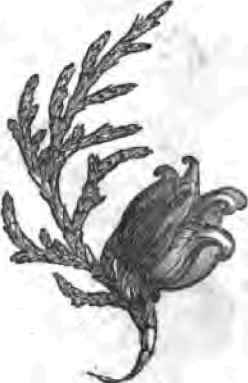Biota Orientalis, Biota Pyramidalis, And Taxus Adpressa. Translated From The Revue Horticole
Description
This section is from "The Horticulturist, And Journal Of Rural Art And Rural Taste", by P. Barry, A. J. Downing, J. Jay Smith, Peter B. Mead, F. W. Woodward, Henry T. Williams. Also available from Amazon: Horticulturist and Journal of Rural Art and Rural Taste.
Biota Orientalis, Biota Pyramidalis, And Taxus Adpressa. Translated From The Revue Horticole
My object in publishing this brief article is to clearly establish the difference existing between two species, which, although perfectly distinct, have often been confounded with each other, or regarded merely as varieties. Their frequent culture from the seed during a long series of years, proves this to be the case. M. Trove has long since established this fact. The drawing and accurate description of it given by him in the memoir of the Academy of Naples, under the name of Thuia pyramidalis, leave, in my mind, no doubt upon the subject.
One of the species, now under consideration, the Biota orientalis (Fig. 1), commonly called the Chinese Thuia, is that generally used in the construction of a blind or screen, as well as, in our cemeteries, to take the place of the cypress. Its straight branches, its numerous and compact ramules, arranged in the shape of a palm-leaf, or a fan, clearly distinguish it from the following (Fig. 2), which the gardeners, in France, generally designate under the name of Thuia Nepalensis, or T. tatarica; the latter is much more bushy; its branches, although numerous, and straight, are furnished with delicate ramules, more elongated and divaricated than the former, imparting to it a peculiar and distinctive appearance.
1 Mem. Acad. Neap., 35, torn. 3.
Independently of this very different aspect, the shape of the cones will not permit us to confound it with the Biota orientalis (Fig. 1), in which each scale of the cone, which is regular, presents a point or straight prolongation, either slightly curved at its apex, and gibbous, or somewhat dilated and enlarged at its base. In the Biota pyramidalis (Fig. 2), on the contrary, the scales of the cones, which are irregular, are furnished, toward the apex, with a long, subcylindrical point, curved at its extremity. The drawing of the ramules, accompanying the cones in the two species, exhibits the difference much more clearly than any written description.
We will avail ourselves of this opportunity to justify the name of Biota, and recommend it to our brethren instead of that of Thuia; for, if too great subdivision is wrong, too great generalization is equally so; on the one hand, objects which are closely suited, are too widely separated; and, on the other, those which have no affinity are included in the same class.
In the first place, the Biota is a native of the Old Hemisphere, while the Thuia, properly so-called, has reached us from the New World; no exception to this geographical distribution is as yet known. In the Biota, the cones, which are large and subglobular, are formed of thick and woody scales, having, at their base, seeds which are almost osseous, and ovoid, rounded, or subcorneal, sometimes slightly compressed, and entirely unfurnished with wings. In the Thuia (T. occidentals), on the contrary, the cones are small, oblong, or subcylindrically elongated, slightly thickened toward the middle, and formed of very thin, cartilaginous, and cork-like scales, having, at their base, very delicate, compressed seeds, of cartilaginous consistence, always provided with a membranous, and nearly transparent wing. By contrasting the two genera, their characteristic marks will be more apparent.
Fig. l.

Fig. 2.

Continue to:


